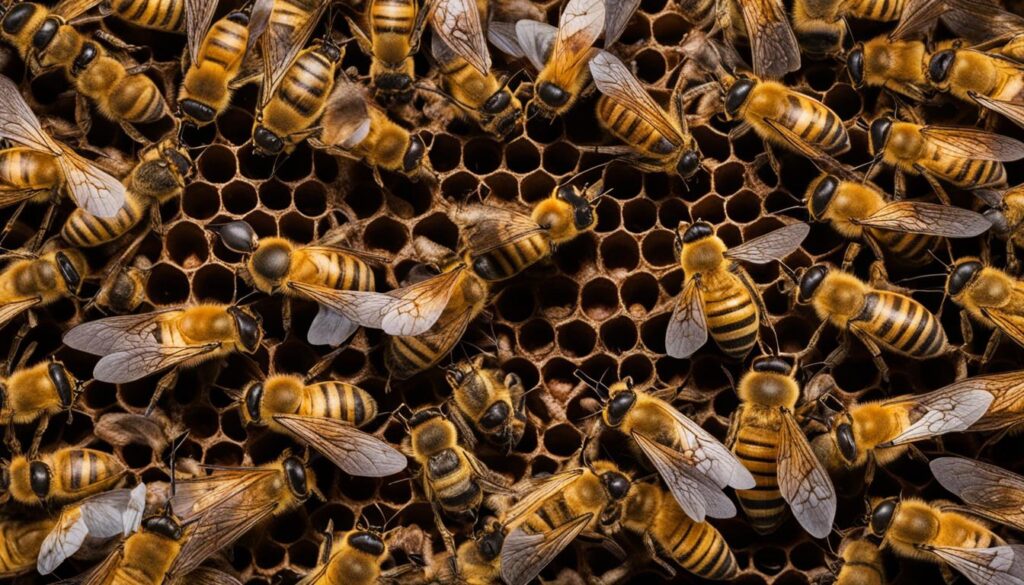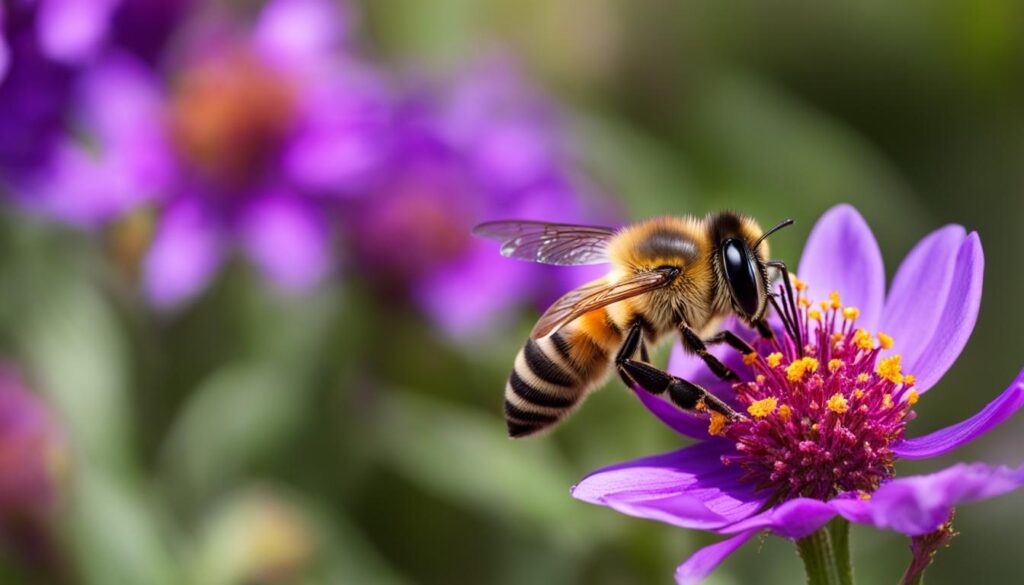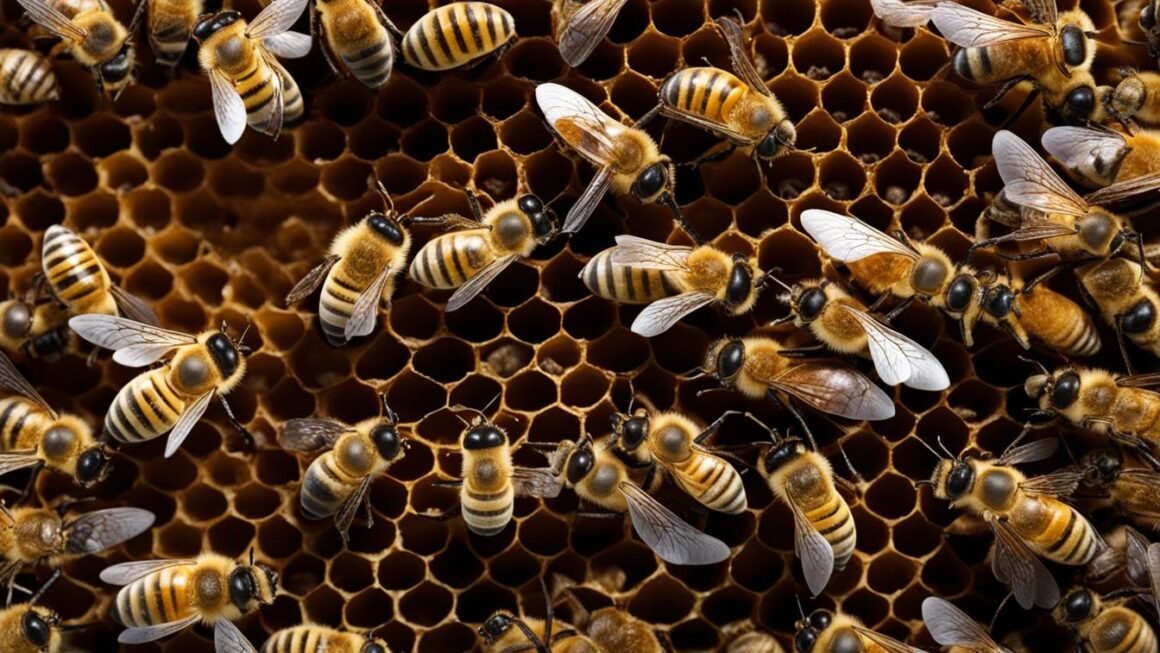Queen bee reproduction is a fascinating process that involves genetic modification and diet differences. By transferring genetic material from breeder queens to cell-building colonies, worker larvae can be redirected to become queen bees. The development of queen larvae is triggered by the diet of royal jelly, while worker larvae are fed worker jelly. This differentiation in diet suppresses queen development in workers, allowing for the efficient production of queen bees on demand.
Key Takeaways:
- Queen bee reproduction involves genetic modification and diet differences
- Worker larvae can be redirected to become queen bees through the transfer of genetic material
- Queen larvae development is triggered by a diet of royal jelly
- Worker larvae are fed worker jelly to suppress queen development
- This allows for the efficient production of queen bees on demand
The Society and Life Cycle of Honey Bees
Honey bees live in a structured social order within a bee colony, with each bee playing a specific role in the hive’s functioning. The colony consists of a queen, female worker bees, and male drones during the mating season. The queen, who has a lifespan of 2-5 years, is responsible for laying eggs in the hive. On the other hand, worker bees have a relatively short lifespan of approximately 6 weeks during the summer. Drones, the male bees, have a crucial role in mating with the queen but die shortly after mating.
The life cycle of a honey bee can be categorized into four stages: egg, larva, pupa, and adult. The queen lays each egg in a separate cell within the hive. Worker bees then cap these cells once the larvae inside grow large enough. The fully developed bees emerge from the capped cells and begin their duties within the hive.
Honey bees have a complex social structure that enables them to function as a productive and efficient unit. Each bee has specific roles and responsibilities within the colony, contributing to the survival and productivity of the hive as a whole.
The Society and Life Cycle of Honey Bees
The Role of the Queen Bee
The queen bee plays a vital role in the honey bee colony. As the mother of all bees, she is the only female bee capable of reproducing. The queen bee has the incredible ability to lay up to 2,000 eggs per day, ensuring the growth and survival of the colony. Her egg-laying prowess is essential for maintaining a healthy population and productivity within the hive.
To maintain her dominance, the queen bee emits a pheromone that prevents other female worker bees from becoming sexually mature. This pheromone acts as a signal, suppressing the development of ovaries in the worker bees and ensuring that they focus on their assigned tasks within the hive.
In addition to her unique reproductive abilities, the queen bee also has a specialized diet. Throughout her life, she is fed royal jelly, a substance rich in protein and nutrients. This exclusive diet plays a crucial role in her development and fertility. The royal jelly enables the queen bee to grow larger and live longer than the worker bees, allowing her to fulfill her important role as the center of the colony’s reproductive system.
The Life of Worker Bees
Worker bees are crucial to the functioning of a honey bee colony, with each individual taking on different tasks as they age. From the moment they emerge as adults, worker bees begin their roles as diligent members of the hive, contributing to honey production and the overall survival of the colony.
Tasks of Worker Bees
As young worker bees, their primary responsibility is to clean and maintain the hive. They remove debris, dead bees, and any other foreign objects that may pose a threat to the colony’s hygiene. Additionally, they nurse and feed the developing larvae, ensuring their growth and well-being.
As they advance in age, worker bees shift their focus to building comb and storing honey. They use beeswax secreted from their own bodies to construct the hexagonal cells of the comb, providing a sturdy structure for storing nectar, pollen, and eggs laid by the queen.
Worker bees also take on the important role of guarding the hive, protecting it from intruders such as predators or rival honey bee colonies. They use their stingers as a defense mechanism, sacrificing their lives in the process to protect the safety and integrity of the hive.
Honey Production
One of the most crucial tasks performed by worker bees is foraging for nectar and pollen, which are essential for honey production. Worker bees visit flowers, collecting nectar with their long tongues and pollen with their specialized hairs. They store the nectar in their honey stomachs and transport it back to the hive, where other worker bees convert it into honey through an enzymatic process.
Worker bees have a remarkable ability to communicate the location of rich nectar sources to their fellow workers. They perform a unique dance known as the waggle dance, which includes specific movements and patterns. By conveying information about distance and direction, they guide other worker bees to the best foraging spots, maximizing the efficiency of honey collection.
Overall, the life of a worker bee is characterized by hard work, selflessness, and dedication to the success of the colony. Through their diverse tasks and unwavering commitment, worker bees ensure the continual production of honey and the sustainability of the hive.
Mating Habits of Queen Bees
Queen bees play a pivotal role in the reproduction and genetic diversity of honeybee colonies. Understanding their unique mating habits sheds light on the complex dynamics of hive development and the importance of genetic variation for the survival of the species.
Queen bees engage in what is known as a “nuptial flight” to mate with drones from other colonies. These flights typically occur in specific areas called “drone congregation areas” where drones from different hives gather. By mating with drones from other colonies, queen bees promote genetic diversity within their own colony, reducing the risk of inbreeding and increasing the chances of survival in changing environments.
During a single nuptial flight, a queen bee will mate with multiple drones to ensure a diverse range of genetic material. The queen stores the sperm from these matings in a specialized organ called the spermatheca. This adaptability helps the colony thrive by providing a mix of genes that can enhance resistance to diseases, adaptability to environmental changes, and overall fitness.

The mating habits of queen bees, particularly their practice of polyandry (mating with multiple drones), contribute to the resilience and success of honeybee colonies. This complex reproductive strategy ensures the survival and adaptability of the hive, highlighting the vital role of the queen bee in maintaining the health and productivity of the colony.
The Life Cycle of Honey Bees
The life cycle of a honey bee is a fascinating journey that begins with the egg and ends with the emergence of an adult bee. It is a process that lasts between 24 to 33 days, and each stage plays a crucial role in the development and survival of the hive.
The life cycle starts with the queen bee laying each egg in a separate cell of the hive. The eggs are tiny, white, and bean-shaped, and they require proper temperature and humidity to develop. Worker bees maintain the hive’s temperature and humidity, ensuring the eggs are in a favorable environment.
Once the eggs hatch, they enter the larval stage. During this stage, the larvae are fed a mixture of honey, pollen, and royal jelly by the worker bees. The larvae grow rapidly and molt several times before spinning a cocoon around themselves and entering the pupal stage.
| Stage | Description |
|---|---|
| Egg | The beginning of the honey bee’s life cycle. |
| Larva | The stage where the bee larvae are fed and grow rapidly. |
| Pupa | The stage where the larvae transform into adult bees within a cocoon. |
| Adult | The final stage where the bee emerges and contributes to the hive. |
Inside the cocoon, the transformation from a larva into an adult bee takes place. This transformation involves the restructuring of cells and tissues, eventually leading to the emergence of a fully developed honey bee. After emerging from the cocoon, the adult bee starts its duties within the hive, contributing to the overall functioning and productivity of the colony.
The Industrious Life of Honey Bees
Honey bees are remarkable creatures known for their incredible work ethic and productivity. They play a crucial role in the production of honey, a sweet and nutritious substance that serves as their food source and is also enjoyed by humans.
The process of honey production is a testament to the hard work of bees. To produce just a single pound of honey, bees must visit around two million flowers and fly a distance equivalent to three times around the Earth. They diligently collect nectar from flowers and store it in their honey stomachs. Back at the hive, they regurgitate the nectar into the cells of the honeycomb and fan their wings to accelerate the water evaporation process. This results in the thick, golden honey we all know and love.
Aside from their impressive honey-making abilities, bees also exhibit surprising intelligence. They can recognize human faces, count, and learn from their experiences. Bees communicate with each other through a unique dance known as the “waggle dance,” which provides information about the direction and distance to nectar-rich flowers. They navigate efficient routes between flowers, optimizing their foraging efforts and ensuring the success of the hive.
Overall, the industrious life of honey bees showcases their tireless dedication to their colony and the vital role they play in our ecosystem. Their hard work and intelligence serve as a reminder of the remarkable capabilities of these tiny creatures.

Table: The Hard Work of Honey Bees in Honey Production
| Task | Description |
|---|---|
| Foraging | Bees visit flowers to collect nectar and pollen, traveling long distances in search of food. |
| Nectar Collection | Bees suck nectar from flowers and store it in their honey stomachs. |
| Nectar Processing | Once back at the hive, bees regurgitate the nectar into honeycomb cells and fan their wings to evaporate excess water. |
| Honey Storage | Bees seal the filled honeycomb cells with wax to preserve the honey for future consumption. |
| Honey Ripening | Bees continue to dehydrate and ripen the nectar in the cells until it reaches the desired consistency. |
| Honey Harvesting | Beekeepers carefully extract the ripe honey from the honeycomb, leaving enough for the bees’ sustenance. |
“The bee is more honored than other animals, not because she labors, but because she labors for others.” – Saint John Chrysostom
The Queen Bee’s Importance in the Hive
The queen bee plays a crucial role in the health and survival of the hive. With the ability to lay up to 1500 eggs per day, she ensures the continuous population growth and productivity of the colony. Her primary function is egg laying, as she serves as the mother of all bees in the hive.
But the queen’s significance goes beyond reproduction. She emits a special chemical called “queen pheromone” that affects the mood and activities of the hive. This pheromone helps maintain cohesion and harmony among the bees, keeping them focused on their tasks and preventing them from becoming sexually mature.
“The queen bee is the heart and soul of the hive. Without her, the colony would not be able to sustain itself and thrive.”
In the event that the queen bee becomes sick or dies, the hive initiates a process to replace her. The nurse bees select newly hatched female larvae and feed them royal jelly, the nutritious substance that plays a vital role in the queen bee’s development. These selected larvae become potential new queens and engage in intense battles to determine who will become the new leader of the hive. This process ensures the continuity and survival of the colony.
| Queen Bee’s Importance | Egg Laying | Pheromone | Queen Replacement |
|---|---|---|---|
| Ensures continuous population growth | Lays up to 1500 eggs per day | Emits queen pheromone for hive cohesion | Nurse bees select potential new queens from larvae |
| Enhances productivity of the colony | Key role in reproductive success | Maintains focus and harmony among bees | Potential queens engage in battles for leadership |
| Pivotal to the survival of the hive | Ensures future generations of bees | Influences behavior and activities of the hive | Replacement process guarantees continuity |
Without the queen bee’s importance in the hive, the colony would struggle to thrive and survive. Her role in egg laying, pheromone emission, and the process of queen replacement ensures the harmonious and productive functioning of the hive. Understanding and valuing the queen bee’s significance allows us to appreciate the intricate dynamics of honeybee colonies and the vital role these remarkable creatures play in our ecosystem.
The Life Span and Replacement of Queen Bees
The queen bee, the mother of the entire bee colony, has a longer lifespan compared to worker bees. On average, a queen bee can live anywhere from 2 to 5 years. However, as the queen bee ages, her ability to lay fertilized eggs decreases, and the overall health of the colony may be affected. If the queen bee dies or is lost, the worker bees take immediate action to ensure the survival of the hive.
The nurse bees, responsible for the care of the brood, identify newly hatched female larvae to become potential queens. These selected larvae are fed a special diet of royal jelly, which triggers their development into queens. The royal jelly provides the necessary nutrients for the queen bee’s growth and fertility. The strongest new queens will ultimately fight until one emerges as the dominant queen, ready to take over the role of the previous queen.
Queen bees mate outside of the hive during nuptial flights. They fly to specific areas known as drone congregation areas, where drones from different colonies gather. During these mating flights, the queen mates with multiple drones, collecting and storing their sperm in her specialized organ called the spermatheca. The stored sperm will allow her to fertilize eggs throughout her lifetime. This practice of polyandry enhances the genetic diversity within the hive and contributes to the overall survival and adaptation of the colony.
| Queen Bee Lifespan | 2-5 years |
|---|---|
| Queen Bee Replacement | New queens are selected and fed royal jelly |
| Mating Flights | Mating occurs outside of the hive |
| Spermatheca | Organ where sperm from multiple drones is stored |
Conclusion
The intricate process of queen bee reproduction is a marvel of nature. From the transfer of genetic material to the differentiation in diet, every step plays a crucial role in the development of queen bees. Understanding the life cycle of honey bees and the important role of the queen bee allows us to appreciate their impact on our ecosystem.
Throughout the hive, the queen bee’s significance cannot be overstated. She lays thousands of eggs per day and emits a pheromone that regulates the behavior of the hive. Her role in the health and survival of the colony is paramount. If the queen bee becomes sick or dies, the hive will create a new queen to carry on the lineage.
By recognizing the importance of queen bee reproduction, we can protect and nurture these remarkable creatures. Their intricate genetic modifications and diet differences contribute to the resilience and productivity of the hive. The honeybee life cycle and the intelligence of worker bees exemplify the harmony and efficiency of their society.
As we continue to explore the world of honey bees, let us remember the crucial role of the queen bee and her reproduction. By safeguarding these intricate processes and understanding their significance, we can ensure the well-being of honeybee colonies and their vital role in our environment.
FAQ
What is the process of queen bee reproduction?
Queen bee reproduction involves genetic modification and diet differences. Breeder queens transfer genetic material to cell-building colonies, redirecting worker larvae to become queen bees. The development of queen larvae is triggered by a diet of royal jelly.
How long do queen bees live?
Queen bees have a lifespan of 2-5 years.
What is the role of worker bees?
Worker bees have various tasks, including cleaning the hive, feeding larvae, building combs, guarding the hive, and foraging for nectar and pollen.
How do queen bees mate?
Queen bees mate outside of the hive during a nuptial flight, where they mate with multiple drones. This practice of polyandry enhances genetic diversity within the hive.
What is the life cycle of a honey bee?
The life cycle of a honey bee consists of four stages: egg, larva, pupa, and adult. It lasts between 24 to 33 days.
How much honey does a single bee produce?
A single bee produces only about 1/12th of a teaspoon of honey in its lifetime.
What is the importance of the queen bee in the hive?
The queen bee is responsible for laying up to 1500 eggs per day and emits a pheromone that affects the mood and activities of the hive.
How long do queen bees live?
Queen bees have a lifespan of 2 to 5 years.
What happens if the queen bee dies?
If the queen bee dies, the nurse bees will prepare emergency queens by selecting newly hatched female larvae and feeding them royal jelly.
How does the replacement of queen bees occur?
The nurse bees prepare emergency queens by selecting newly hatched female larvae and feeding them royal jelly. The new queens will fight, and the strongest one takes over.




